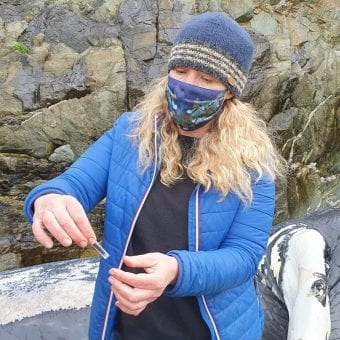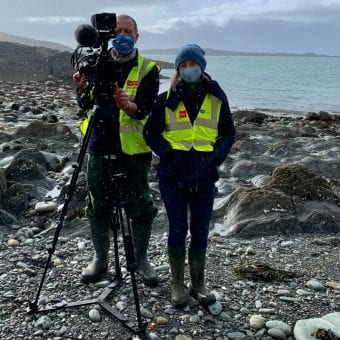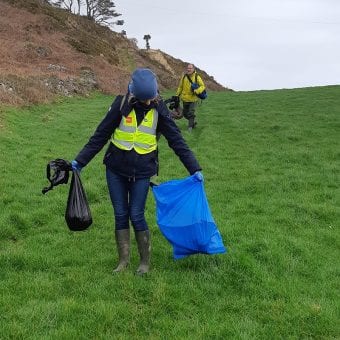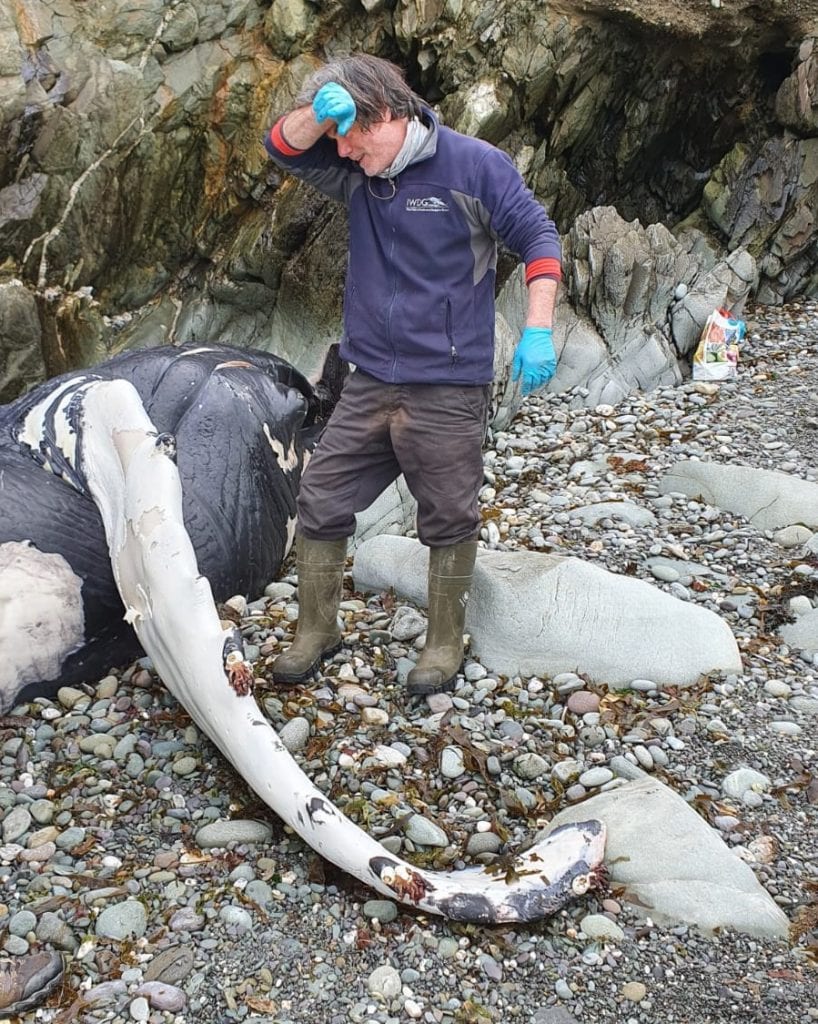28th February, 2021
With the humpback whale ashore on the afternoon of Wednesday 24 February, so began a lot of phoning around so that relevant agencies and key individuals were brought into the loop and a coordinated approach lead by the IWDG could be taken. This is the IWDG approach to large whale stranding events such as this, and is a key aspect of the draft IWDG Large Whale Stranding protocol.

Helen Tilson of Schull Sea Safari (and IWDG) assisting with the humpback examination Fri. 26th Feb © IWDG
So local IWDG members first needed to provide safe access to the site near West Colla, as the whale’s resting place was on a rocky stretch of coastline with a steep and dangerous bank to climb down. They also ensured the carcass wasn’t scavenged or interfered with ahead of the examination. So while this was being prepared on Thursday 25th, the IWDG were planning how best to examine the animal and what samples we needed to obtain in order to extract the maximum amount of details from this specimen, which may help us in time establish what this juvenile male humpback may have died of and to learn more about the ecology of this iconic species in the North Atlantic.

Linear scar which may be evidence of rope mark near pectoral fin © IWDG
So with a plan hatched and personnel arrangements made, we met up with Helen Tilson of Schull Sea Safari (and local IWDG member) at Colla Pier at 08:00 am and headed out to the site where the local ground team had installed the ladder system to ensure safe access for personnel and equipment to the rocky shoreline below. The first task was a visual examination of the animal to check for any obvious signs of anthropogenic impacts such as entanglement or ship strike. We found no direct evidence of either but did find a long linear scar around the shoulder (image right) and near the pectoral fin, which may have been caused by a rope. But best to avoid over speculating at this stage.
We then took precise measurements along the ground and can confirm that the actual length from rostrum to caudal notch was just under 9 metres with the one pectoral fin that was available measuring 2 mt. Also more detailed examination of the genital area confirmed gender as male. Then came the gory bit….

IWDG’s Pádraig Whooley removing blubber sample for analyses © IWDG
It’s generally a good idea to start with the tricky tasks, one of which is the removal of some baleen… the first plate is always difficult, but once this is out then others tend to be quite easy to remove. But why on earth would we want to remove these? Well within the structure of the proteins in a baleen plate there is a window into the feeding ecology of this individual over many years, sometimes decades, which for this individual would be its entire life. Using stable isotope analysis this can reveal where the whale had been feeding; high or low latitudes, inshore or offshore. So a baleen plate for researchers is a lot more than a piece of keratin and modified hair.
Next up was a relatively simple task of taking skin samples, which required no cutting as to be honest whales slough skin off like layers of an onion and so these went straight in small vials prefilled with ethanol to keep the samples pure. These skin tissue samples will go to our colleague in the Netherlands, Per Palsbøll who is carrying out long-term research into the genetics of humpback whale populations in the North Atlantic and further afield and with whom we have been sending all our samples from Ireland (and Cabo Verde).
Then more cutting as we needed to retrieve larger blubber samples which is the layer just under the skin. These revealed a blubber thickness of 65-75 mm, which doesn’t suggest the whale was undernourished. The lipid content within the blubber is key to exploring this dynamic, but generally a humpback of this size would have a thinner blubber layer if it was in a poor nutritive state.
These samples are also crucial for investigating the contaminant burden of persistent pollutants, which build up in the blubber layer. Large samples enable a smaller sample to be extracted from the larger sample, thus avoiding any contamination. This work will be carried out by a PhD student at the Galway-Mayo Institute of Technology who is part-funded by the IWDG. These samples were immediately wrapped in aluminium foil and maintained under temperature control en route back to West Clare.

Bringing the story to as wide an audience as possible with Canola Pictures ©IWDG
Finally, beneath the blubber layer we find the muscle and samples of this red meat were also secured. All of this was carried out under the watchful gaze of our colleagues in the National Parks and Wildlife Service (NPWS) and we’d like to thank both Declan O’ Donnell and local ranger Paddy Graham for giving up their time to oversee this procedure, which was carried out in collaboration with NPWS who provide an annual grant towards the IWDG Cetacean Stranding Scheme. IWDG’s media team were also present to document this work and interview those present, whilst adhering to all Covid-19 guidelines. Such is the rarity of a humpback whale stranding in Ireland, with this being only the 9th record of this species stranding here since 1893, it was important to document this event and the examination while we could.

Removing tissue samples 26th Feb © IWDG
This is not necessarily the end of the story for this whale; as there is local interest in the retrieval of this carcass for burial with a view to displaying the skeleton at some time in the future. This is a long, difficult and smelly job, but a very worthwhile community project, especially during these Covid times. The precedent for this has been set with the Kilbrittain fin whale (2010) and so IWDG wish the local team every success in this project should it go ahead and are happy to offer any support and guidance on this.
Huge thanks to everyone locally who supported IWDG in this task, in particular Helen Tilson, Robbie Shelley, Richie Shelley, Maurice Caughlin, Declan O’ Donnell (NPWS) and Paddy Graham (NPWS).
By Pádraig Whooley, IWDG
Humpback whale examination, Colla, West Cork
Humpback Whale Washed up In Roaringwater Bay, Co Cork: Part I
25th February, 2021
In recent years sightings of humpback whales have been on the increase and the Irish humpback catalogue now recognises 109 individuals in Irish waters. Many of which return year after year and some between decades. And so as this iconic species seems to be enjoying a recovery with different humpback populations recovering well, it comes as no surprise that we can expect more individuals stranding along the Irish coastline.
Historically however, humpback whale strandings are rare events and the IWDG had up until today recorded only 8 previous stranding records, which date back as far as 1893. So today’s specimen, which was initially seen in mid afternoon north of Long island and finally came ashore near Coney Island, west of Schull, is only the 9th ever recorded stranding of a humpback whale in Ireland, and only the 2nd for County Cork…the first being in Tralong Bay in July 1992.

Fluke image. IWDG could not match it on the Irish Humpback Catalogue
Images taken today reveal sufficient detail of the genital area to confirm this is a male, from the absence of mammary slits or a hemi-spherical lobe. Additional images on the ventral fluke surface (see image left) have enabled us run it through the Irish Humpback Whale Photo ID Catalogue curated by the IWDG and we can confirm that this is not an individual previously documented in Irish waters. Which of course is not to say that it has never been here before. Measurements taken suggest it is just under 9 metres from tip of rostrum to caudal notch, and so this would put it in the sub-adult or juvenile length range, which is to expected as we are now moving into humpback breeding season and most adults of breeding age are either en route to or already at the low latitude breeding sites.
This is something that some young humpbacks can opt out of, as it’s a long track south to places like the Cabo Verde and with no hope of successfully breeding there is nothing much in it for them. So a cohort of young, independent humpbacks seem content to over winter at higher latitudes, where there is, or should be, plenty of food for them.

Final resting place, Feb. 24th 2021
So the big question is what could have happened to this young animal? Well, the images we’ve received so far suggest it is in rather thin condition and so it may not have fed for some time. There are no obvious signs of rope marks or net damage that may suggest entanglement in fishing gear…something that slow swimming humpbacks that remain inshore are prone to; and there are no large traumas to suggest ship-strike. So as is so often the case, the circumstances underpinning this stranding are unclear. IWDG hope in the coming days to visit the site to take detailed measurements and get skin and blubber samples which can be used for genetics, contaminants and stable isotope analyses.
IWDG have consulted with local National Parks & Wildlife Service on this situation and will work closely with them and Cork County Council in relation to further examinations and to discuss its removal if this is what the Council decide. But at its current remote location, far from houses or popular beaches, there is no strong case for removal. We extend a huge thanks to those on the ground today who kept us updated on events as they arose….in particular Roseanne and Robbie Shelly and local IWDG member Helen Tilson of Schull Sea Safari
Images above courtesy of Robbie Shelly and Helen Tilson
Any sightings or strandings of humpback whales should be reported to IWDG on www.iwdg.ie
By Pádraig Whooley, IWDG Sightings Officer

